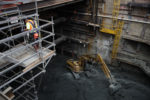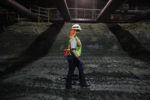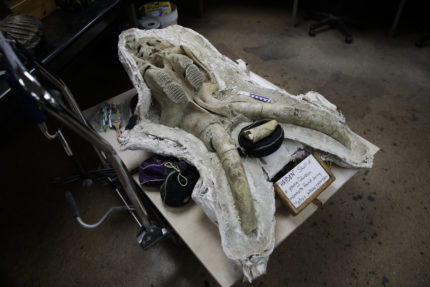 The expansion of the subway system in Los Angeles, California, has an unexpected commonality with Rome’s tortured endeavors to build a new line through the historic center: the ground under these cities is crammed full of the remains of the current residents’ predecessors. In Rome’s case it’s ancient archaeological materials, while Los Angeles’ specialty is Ice Age fossils. The company that has LA’ contract for digging the new tunnels keeps a paleontologist on call at all times so that whenever they find something, which is often, it can be properly handled and recovered by a professional. It’s a state regulatory requirement that has ensured the protection of cultural and natural historic patrimony since subway construction first began the 1990s, an attempt to right the many wrongs done to Los Angeles’ history and prehistory during its earlier spurts of rapid growth.
The expansion of the subway system in Los Angeles, California, has an unexpected commonality with Rome’s tortured endeavors to build a new line through the historic center: the ground under these cities is crammed full of the remains of the current residents’ predecessors. In Rome’s case it’s ancient archaeological materials, while Los Angeles’ specialty is Ice Age fossils. The company that has LA’ contract for digging the new tunnels keeps a paleontologist on call at all times so that whenever they find something, which is often, it can be properly handled and recovered by a professional. It’s a state regulatory requirement that has ensured the protection of cultural and natural historic patrimony since subway construction first began the 1990s, an attempt to right the many wrongs done to Los Angeles’ history and prehistory during its earlier spurts of rapid growth.
 The latest fossil bumper crop has been springing up since 2014 when construction on the extension of the Metro Purple Line started. Paleontologist Ashley Leger of Cogstone Resource Management (CGM) was contracted to examine any finds made by work crews excavating tunnels. Whenever they found something, they’d stop what they were doing, call her and move over to another location to continue work on the project. That gave her the space she needed while still keeping the extension on some semblance of a schedule. The construction crews even pitch in when help is needed.
The latest fossil bumper crop has been springing up since 2014 when construction on the extension of the Metro Purple Line started. Paleontologist Ashley Leger of Cogstone Resource Management (CGM) was contracted to examine any finds made by work crews excavating tunnels. Whenever they found something, they’d stop what they were doing, call her and move over to another location to continue work on the project. That gave her the space she needed while still keeping the extension on some semblance of a schedule. The construction crews even pitch in when help is needed.
Most of the finds haven’t required their aid. Leger has unearthed, among other remains, fragments of a rabbit jaw, one mastodon tooth, the foreleg bone of a camel, several bison vertebrae, one tooth and one ankle bone from a horse. But, appropriately for a show business industry town, Los Angeles had something far more spectacular saved up for her. Last year, she got a late night call from one CGM’s site monitors. He said they’d found something and that “it looks big.”
The next morning, Leger knelt at the site and recognized what appeared to be a partial elephant skull.
It turned out to be much more. After 15 hours of painstaking excavation, the team uncovered an intact skull of a juvenile mammoth.“It’s an absolute dream come true for me,” said Leger, who spent the previous decade at a South Dakota mammoth site with no discoveries even close to the size of the one in Los Angeles. “It’s the one fossil you always want to find in your career.” […]
From there, the skull was hauled a mile or so to Los Angeles’ La Brea Tar Pits and Museum, home to one of America’s most fossil-rich sites.
Assistant curator Dr. Emily Lindsey called it a “pretty remarkable find,” noting that while thousands of dire wolf and saber-toothed cat remains have been uncovered in L.A., there have been only about 30 mammoths.A few hundred pounds and the size of an easy chair, the skull is especially rare because both tusks were attached. It’s being studied and is available for public viewing inside the museum’s glass-walled Fossil Lab.
The skull with its glamorous attached tusks and those crazy mammoth teeth with the Golgi Apparatus-looking molars was named Hayden after the actress Hayden Panettiere who was apparently on TV when the CGM monitor first spotted the big head.
